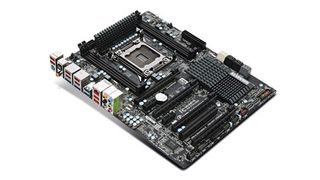
To the engineer, the motherboard might seem the poor relation to the processor and the hard disk, but while the complexity of its manufacture might not compare, the substances used are no less intriguing.
The printed circuit board (PCB) is a sheet of material with conducting copper tracks printed onto both sides and sandwiched in several intermediate layers. The tracks make the connections between the components, and the sheet onto which they're printed provides mechanical strength while insulating between the layers of connections.
Copper is far more common than the likes of ruthenium and neodymium. It's been used for millennia, is 10,000 times more abundant than platinum and thousands of times cheaper. It's one of the most important materials in a PC, and you'll also find it in the various cables that connect components like the hard disk and the CD/DVD drive to the motherboard.
The property of copper that makes it so important to the electronics industry is its electrical conductivity. Although it's not the most conductive material, if it was pensioned off in favour of silver - the only metal that's more conductive - the cost of electronics would soar.
Perhaps the most astonishing thing about copper is the vast scale of its production. From its discovery in the fourth century BC in tiny mines on the island of Cyprus (where copper gets its name), copper ore is now extracted from huge open cast pits. Bingham Canyon Mine near Salt Lake City in Utah, currently the world's biggest producer of copper, is 1.2km deep and 4km wide, covering an area of 1,900 acres. The annual production of 300,000 tonnes of copper is brought to the surface in trucks standing seven metres tall and weighing more than a jumbo jet.
The other element of a PCB, the insulating sheet, might seem simple, but appearances can be deceptive. The PCBs used in today's motherboards have to provide the ideal combination of electrical, thermal and mechanical properties. They also have to meet safety requirements so that if a component fails and overheats, the board won't catch fire and emit toxic fumes.
The most common insulating material today is FR-4, which comprises sheets of woven fibreglass bonded by flame-retardant epoxy resin. Many manufacturers use a similar material for simple car body repairs, but its function in PCBs is much more complex.
Get daily insight, inspiration and deals in your inbox
Sign up for breaking news, reviews, opinion, top tech deals, and more.
Here we get into the murky world of organic chemistry. The two compounds that form epoxy resin are chloromethyloxirane (otherwise known as epichlorohydrin), and 4,4'-(propane-2,2-diyl)diphenol (otherwise known as bisphenol-A). We could tell you that the former has the chemical formula C3H5ClO, and the latter is C15H16O2, but this isn't particularly helpful since in organic chemistry, two substances can share the same chemical formula but differ in their structure.
We're not going to get embroiled in molecular diagrams, though. All we need to know is that when these two liquids are mixed together, a polymerisation reaction takes place that results in a much larger molecule, which forms a solid. This in turn bonds the fibreglass sheets and fills the holes in the weave to produce a tough, insulating, flame retardant sheet to which copper foil can be applied.
Resistors
If you take a look at a motherboard you'll see lots of small components that look like tiny black blocks and metallic cylinders. Most of these will be either resistors or capacitors, which electronics engineers refer to as passive components.
There isn't room here to explain the functions of each one (see here for a guide to basic electrical components), but as with most parts of a PC, delving inside the passive components brings to light yet more unusual substances.
Resistors do what the word suggests - they resist the flow of an electrical current. They differ in their resistance (measured in Ohms, a unit of how much they impede the flow of electricity) and their power rating (how much power they can dissipate by resisting that current without burning out).
Early resistors were little more than a cylinder of carbon, but those days are long gone, and even in this most basic of all components we can now find quite a mix of elements.
The major part of a resistor is a ceramic block, typically made of aluminium oxide (alumina), which gives the finished component enough bulk to be handled and soldered. This material is used because it's a near-perfect insulator.
The electrical path is made by depositing a film of ruthenium oxide. Unlike most metal oxides, this material has limited electrical conductivity, which is exactly what's needed. To cap it all off, metal electrodes made from an alloy of platinum, palladium and silver are attached at each end.
Palladium, like ruthenium, rhodium, osmium, iridium and platinum itself, is referred to as a platinum group metal. These elements are grouped together in the periodic table, but they're also found together geographically - most notably in the Bushveld complex of South Africa - and they all command a high price.
Since they're often found together in the same ores, platinum group metals have to be separated before use. This is difficult due to their similar properties, and necessitates an expensive multi-stage chemical process, which you can read about here.
Capacitors
Capacitors allow an AC current to pass while blocking a DC current. At their simplest, they're formed from two sheets of metal separated by an insulator called the dielectric. Of course, things are rarely that simple and a motherboard will contain lots of different types of capacitor, each suited to a particular application.
Those with the lowest capacitance (a property measured in Farads) tend to be ceramic capacitors, and while they look similar to resistors, their construction is different. The dielectric is made from ceramic, which is plated with silver to form the two metal sheets. This structure is stacked vertically to achieve the necessary capacitance without taking up too much space on the PCB.
If they were built this way, the large capacitors that are needed in a PC's power supply and audio circuitry would be huge, so various types of electrolytic capacitors are used instead.
The original type of electrolytic capacitor was formed by rolling up layers of aluminium foil, sandwiched with paper soaked in an electrolyte. That electrolyte was usually boric acid or sodium borate, with other materials added to prevent it from evaporating.
You'll still see this type of capacitor on some motherboards as little metallic cylinders but they have one drawback - if they overheat the electrolyte evaporates, causing the case to bulge or burst and gunge to leak out all over the motherboard. Needless to say, this doesn't have a particularly beneficial effect on the workings of the PC.
Liquid electrolyte capacitors are being phased out in favour of so-called polymer capacitors, which brings us to that 7,7,8,8-tetracyanoquinodimethane, which provides a replacement for the liquid electrolyte. Polymers based on this organic compound are plastics, but unlike most plastics they can conduct electricity.
One other important type of capacitor that can provide a particularly high capacitance for its volume is based on an element that we've not come across so far. We won't go into detail about the capacitor's internal construction, but the element it uses is tantalum.
Although it's a metal, tantalum has unusual properties that make it particularly suitable for manufacturing capacitors. But like hafnium, our supplies are running out. It's not that it's inherently rare - at one part per million in the Earth's crust, it's a thousand times more abundant than ruthenium. The problem is that, for a variety of political reasons (not least of which being that it's mined in the troubled Democratic Republic of Congo), experts have suggested that stockpiles will run dry sometime between 2015 and 2105.
If you know your way around the periodic table you might just know where to go if and when supplies of tantalum do run out. Tantalum has an atomic weight of 73, which puts it in the group of elements known as rare earth metals. Immediately above it is element number 41 – niobium.
While not strictly speaking a rare earth metal, niobium has remarkably similar properties to tantalum, and is much more abundant. It looks much the same, and has a similar density, melting point and boiling point to tantalum. Most importantly, scientists think it could form the basis of a new form of capacitor.
Solder
Unlike the big and expensive components like the processor and memory, which are fitted into sockets on the motherboard when the PC is built, the passive components are soldered in place by the motherboard manufacturer.
Solder, the low melting point alloy used to make an electrical and mechanical connection between the lead or pin of a component and the copper track on the PCB, was originally made from tin and lead. The type normally used in electronics was 63 per cent tin and 37 per cent lead, and had a melting point lower than that of pure tin, pure lead, or any other alloy of these two metals.
Once again we're seeing that although an alloy is essentially a mixture of two metals, its properties aren't always intermediate between those of its constituents. All that changed in 2006, when the European Union's Waste Electrical and Electronic Equipment (WEEE) and Restriction of Hazardous Substances (RoHS) directives came into effect.
Lead was banned in all consumer goods because of its toxicity, and the electronics industry had to find a new form of lead-free solder. An alloy of tin, silver and copper is most commonly used, and has a melting point a touch higher than old-fashioned lead solder. However, lots of other formulations have been used, with zinc or manganese being added to the mix to improve other properties.
An organic future?
While silicon is perhaps the most important material in an average PC, we've unearthed a wide range of elements and compounds, without which modern computing would be impossible. It's been estimated that well over 50 of the 90 naturally occurring elements are used to make the digital age a reality.
Many of these are in limited supply and for some there's no known alternative. Given the rate at which irreplaceable resources are being used up, we have to question how much longer we can expect business as usual.
There is a glimmer of hope though. While each element has unique properties that can be matched by no other, organic chemistry can provide a means of designing molecules with the desired properties.
What's more, the synthesis of organic compounds doesn't rely on esoteric and rare elements. Already scientists have produced conducting and semi-conducting polymers and built electronic circuits from nothing more than plastics - although, as yet, they can't match the performance of silicon.
Given the vast number of possible organic compounds, a PC of the future may contain no fewer amazing substances, but if the organic revolution takes off, the chances are they'll be radically different from the materials in today's PCs.













